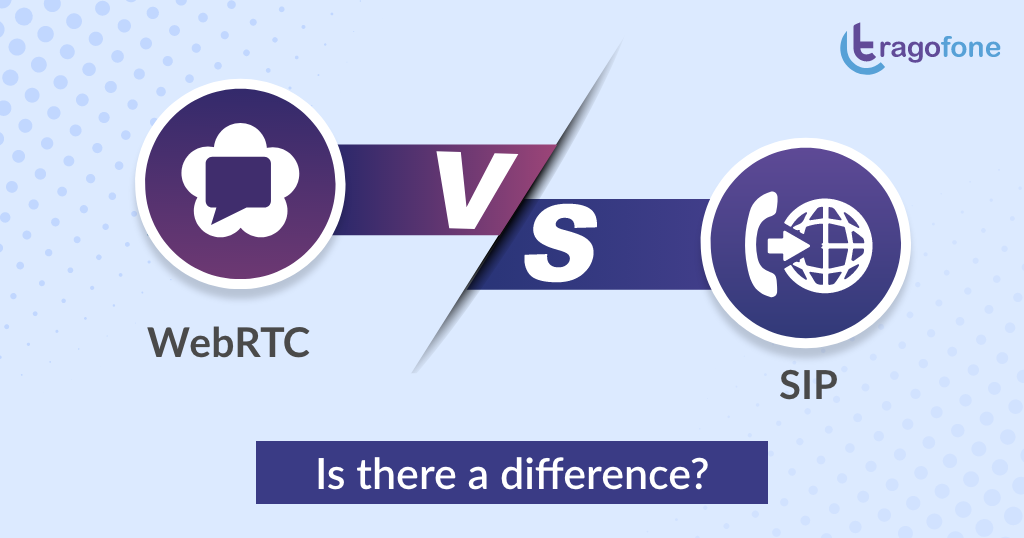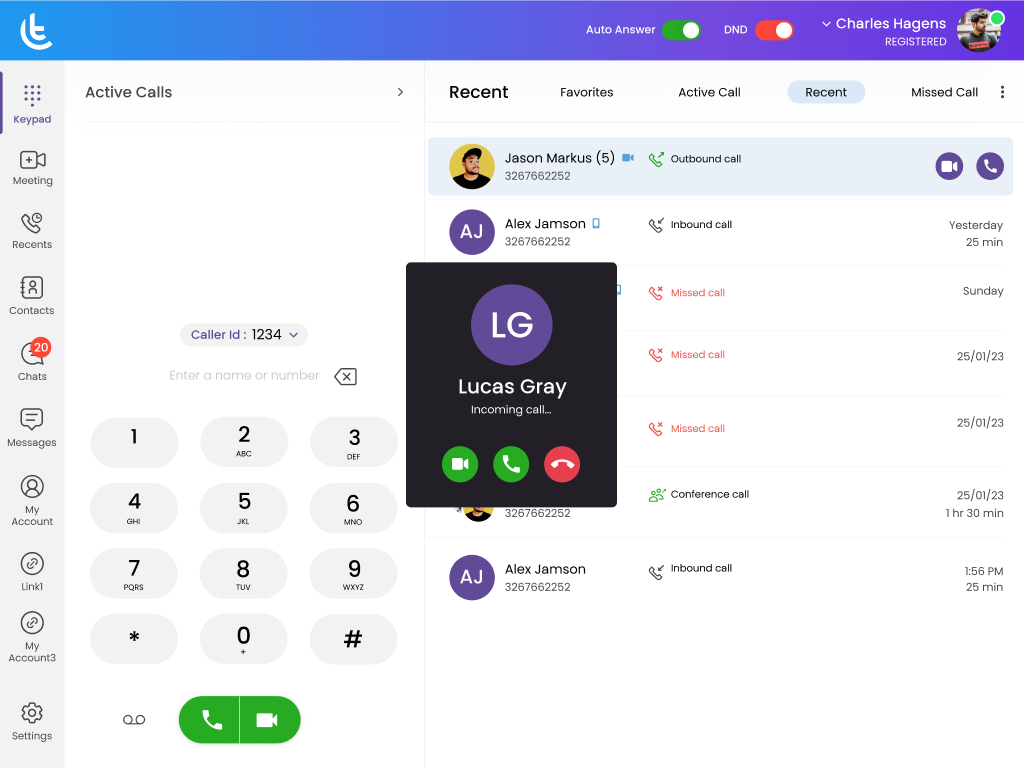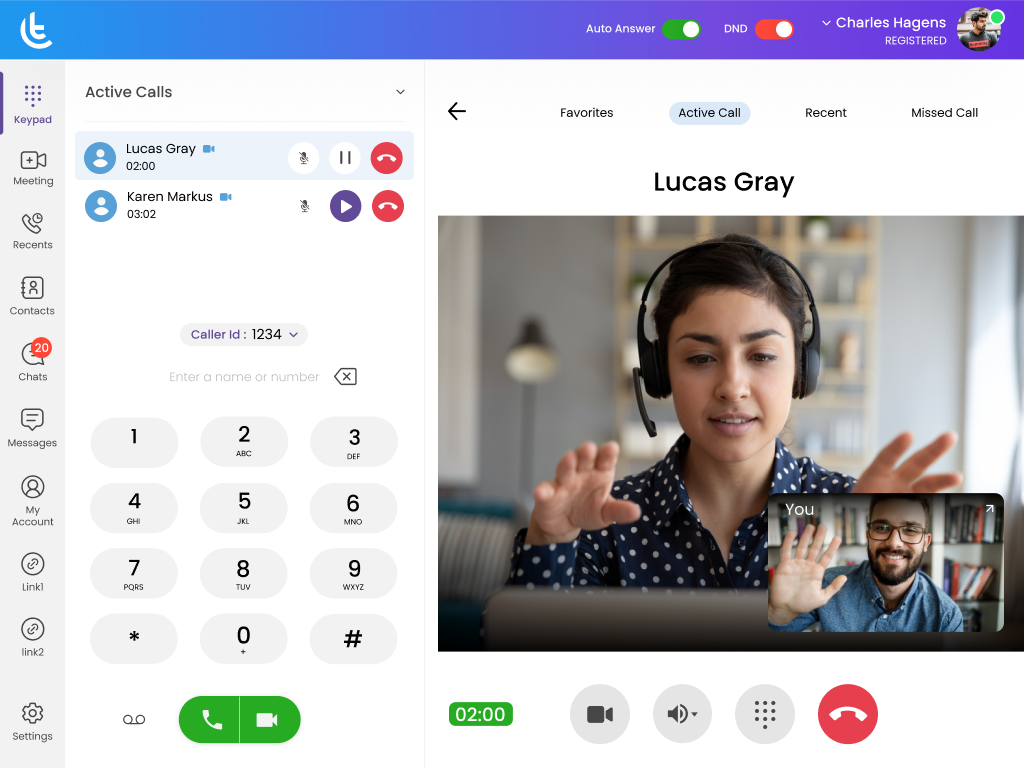
When choosing a VoIP communication solution, such as a helpdesk, browser-based telephony app, softphone, or customer support platform, you may encounter two key terms: WebRTC and SIP. They are among the most widely used and talked-about technologies in VoIP services.
WebRTC (Web Real-Time Communication) is an open-source framework that enables real-time communication capabilities directly through web browsers and mobile applications, eliminating the need for additional plugins or software.
On the other hand, SIP (Session Initiation Protocol) is a signaling protocol used to initiate, maintain, and terminate real-time communication. Understanding the difference between WebRTC and SIP is essential before deciding whether to adopt one or both in your communication stack.
This guide explains how WebRTC and SIP work, compares them head-to-head based on performance, security, and demonstrates how they can be integrated.
What is WebRTC?
WebRTC is a browser-native protocol that enables real-time audio, video, and data sharing directly through a web browser, without requiring any plugins or additional applications. Whether building a browser-based telephony solution or an in-browser calling experience, it gives you the tools to support peer-to-peer VoIP communication.
Example: Safari 18.0 introduced enhancements to the getStats API, providing more detailed statistics for improved debugging, browser compatibility, and enhanced performance monitoring for WebRTC applications.
What is SIP?
SIP (Session Initiation Protocol) is a signaling protocol used to initiate, manage, and terminate voice, video, and messaging sessions over IP networks. It’s the backbone that powers everything from office desk phones to enterprise-grade web-based SIP clients.
For businesses adopting hybrid stacks, SIP offers a time-tested, server-driven model that integrates with PBX systems and enables sophisticated VoIP communication infrastructures.
WebRTC vs SIP: Detailed Comparison
| Feature |
WebRTC |
SIP |
| Functionality |
- Browser-based, peer-to-peer communication
- Uses WebRTC APIs: getUserMedia(), RTCPeerConnection(), RTCDataChannel()
- No middleware; direct communication
- Supports VP8 (video) and Opus (audio) codecs
|
- Session initiation, modification, and termination
- Works with RTP for media transmission
- Handles signaling messages (INVITE, BYE, ACK)
- Interoperability with various systems, including PBXs, softphones, etc.
|
| Media Handling |
- Peer-to-peer architecture reduces latency
- Direct media exchange between clients
- DTLS and SRTP encryption by default
|
- Does not handle media; works with RTP for streaming
- SIP client handles signaling, WebRTC handles media in WebRTC-SIP client integration
|
| Security |
- Built-in encryption using DTLS and SRTP
- End-to-end encryption for both signaling and media layers
|
- TLS for signaling encryption
- SRTP for media encryption
- Requires manual configuration for encryption and authentication
|
| Compatibility |
- Natively supported in web browsers
- No need for additional software or plugins
- Ideal for browser-based telephony
|
- Compatible with legacy systems, VoIP infrastructure, and web-based SIP clients
- Works across a wide range of devices (IP phones, softphones, etc.)
|
| Scalability |
- Suitable for small-to-medium scale applications
- Peer-to-peer architecture limits scalability
|
- Designed for large-scale enterprise deployment
- Highly scalable for high call volumes
|
| Ease of Setup |
- Easy to implement in web-based softphone solutions
- Minimal setup, no plugins or software
|
- Requires SIP server and network setup for interoperability
- More complex configuration compared to WebRTC
|
| Use Cases |
- Real-time video conferencing, browser-based telephony
- Customer support platforms, e-commerce communications
|
- Enterprise communication systems, PBX systems
- VoIP call centers, internal communication systems
|
| Cost |
- Cost-effective as it’s open-source and doesn’t require licenses
|
- Can involve licensing and additional infrastructure costs
|
WebRTC vs SIP: Functionality
The functionality of WebRTC focuses on the ease of access and simplicity of real-time interactions. Here’s how it works:
- WebRTC APIs: WebRTC utilizes APIs such as
getUserMedia(), RTCPeerConnection(), and RTCDataChannel() to capture media streams, establish peer connections, and transmit data.
- No Middleware: It directly establishes communication between two devices, bypassing traditional server routing, which reduces the latency for real-time interactions.
- Standardized Media Codecs: WebRTC supports VP8 and Opus, which are used for video and audio, respectively, to ensure the highest quality of real-time communications without external dependencies.
- Encryption by Default: WebRTC automatically encrypts the media, ensuring secure communication between peers. Every connection is encrypted using DTLS and SRTP, protecting both the signaling and media layers.
SIP, on the other hand, serves as the backbone for voice over IP (VoIP) systems, enabling various devices and platforms to communicate seamlessly. Here’s how it works:
- Session Control and Mid-Call Changes: During a session, SIP manages changes such as call hold, transfer, or renegotiation of codecs or media types. It utilizes signaling messages, such as BYE, ACK, and UPDATE, to handle these changes efficiently.
- Media Handling: SIP itself doesn’t carry media. Instead, it works with protocols like RTP to stream audio and video. If you are using a WebRTC SIP client, SIP handles signaling while WebRTC manages encrypted media streams inside the browser.
- Interoperability: SIP enables traditional PBX systems, cloud-based VoIP systems, and others to communicate with each other, ensuring flexibility across various platforms.
- Compatibility: SIP supports a range of devices, including IP phones, software-based clients (also known as softphones), and mobile applications, making it highly versatile for enterprise communication.
Devices, such as softphones or IP phones, register with a SIP server using REGISTER requests. This process enables your system to know who is available and where they can be reached, which is key for presence-based routing.
While WebRTC handles the media flow, SIP manages the session control and communication between devices.
WebRTC vs SIP: Benefits
WebRTC and SIP both offer unique benefits, which make them a critical factor for comparison. Here are the benefits that each communication stack provides.
WebRTC Benefits
- Cost-effectiveness: As an open-source framework, you won’t have to worry about licensing fees, making it affordable to deploy web-based softphone solutions or develop WebRTC-based softphone apps for your business.
- Ease of use: Using WebRTC, you can implement communication services directly into your web browser. Users don’t need to install plugins or extra software, which means browser-based telephony becomes a simple and effective solution for your business.
- Flexibility: Whether you are working on mobile or desktop, WebRTC offers compatibility across a range of devices, allowing you to scale your VoIP communication needs as your business grows.
- Scalability: With WebRTC’s peer-to-peer architecture, your business can easily handle increased traffic without overburdening the server.
SIP Benefits
- Scalability for Large Enterprises: SIP is designed for scalability, enabling your business to handle a large number of calls or video conferences effectively. For example, web-based SIP clients offer a reliable solution for handling high call volumes with enterprise-grade infrastructure.
- Mature Ecosystem: SIP has been in the market for decades, with an established ecosystem of devices and software. This makes it easier for you to integrate VoIP communication solutions into your existing infrastructure.
- Interoperability: If your business has already invested in legacy systems, SIP allows you to connect new web-based SIP clients with older systems, making it easy to upgrade without overhauling everything.
- Cost Savings for Enterprise Solutions: If your business is transitioning from older systems, SIP allows you to use your existing network infrastructure to handle voice and video calls, reducing overall operational costs and making communication more efficient.
Now that you understand the key benefits of both WebRTC and SIP, it’s time to examine how each technology addresses security.
WebRTC vs SIP: Security
WebRTC has built-in security features, making it a strong candidate for businesses seeking secure VoIP communication solutions. Let’s see how WebRTC provides security:
- With WebRTC SIP client integration, DTLS ensures encrypted signaling, and SRTP secures the media stream, making it an ideal solution for businesses requiring browser-based telephony.
- This end-to-end encryption ensures that sensitive audio, video, and data are securely transmitted between devices. This approach reduces the requirement for additional encryption protocols for each session.
- As WebRTC is a browser-based protocol, it benefits from the built-in security features offered by modern web browsers, such as Chrome and Safari.
- Unlike SIP, which requires external security protocols, WebRTC’s signaling and media channels are both encrypted by default, simplifying security management.
SIP does not have the exact built-in security mechanisms as WebRTC. However, it offers flexible security protocols to protect communication. Here’s how SIP secures communication:
- SIP uses TLS (Transport Layer Security) to encrypt signaling messages. This ensures that SIP communications, such as registration, call initiation, and call termination, are protected from interception.
- Businesses using web-based SIP clients must configure TLS to secure signaling traffic, making SIP highly adaptable but requiring careful setup and configuration.
- For securing media streams, SIP relies on SRTP (Secure Real-time Transport Protocol). SRTP ensures that voice and video data transmitted during a SIP session is encrypted, maintaining confidentiality and integrity.
- SIP systems require authentication for devices and users to ensure that only authorized participants can join the call. SIP communications utilize mechanisms such as digest authentication, where users provide a password or token to authenticate their identity.
Although highly customizable and compatible with various security layers, SIP demands more technical expertise to set up correctly. However, WebRTC enables your business to deploy a secure VoIP communication solution without relying on external protocols.
Integration of WebRTC and SIP: How Do WebRTC and SIP Co-exist?

WebRTC and SIP are two communication technologies that serve different purposes but can be integrated to provide businesses with flexible, scalable communication solutions. Here’s how they work together:
WebRTC and SIP: Complementary Technologies
- WebRTC’s browser-based telephony solution is ideal for businesses seeking to offer web-based softphone applications for customer-facing services or internal collaboration.
- SIP is widely used in VoIP communication systems, powering everything from IP phones to enterprise SIP clients.
How WebRTC and SIP Co-exist?
WebRTC and SIP can be integrated seamlessly in communication systems, where WebRTC handles the media layer (audio, video, and data transmission) and SIP manages the signaling (call initiation, modification, and termination).
Signaling Through SIP: SIP acts as the signaling protocol, handling call setup and session management. It is responsible for:
- Initiating a call (via INVITE message)
- Maintaining the session (via ACK and UPDATE messages)
- Ending the session (via BYE message)
WebRTC, on the other hand, does not handle signaling natively. To integrate WebRTC with SIP, businesses use SIP signaling to initiate and terminate the communication session, while WebRTC manages the media (audio/video) exchange once the call is established.
WebRTC and SIP Communication Flow
Here’s how a typical WebRTC and SIP interaction works:
- Initiation: The SIP client sends an INVITE to the SIP server to initiate a call. At the same time, WebRTC sends media negotiation requests using the SDP (Session Description Protocol) within the SIP messages.
- Connection Setup: SIP then handles the network traversal, routing the call to the appropriate WebRTC client. The WebRTC client then establishes a peer-to-peer connection using ICE, STUN, and TURN protocols to find the optimal route between the two devices.
- Media Handling: Once the SIP signaling successfully establishes the call, WebRTC handles the actual media exchange (audio, video, and data) between the clients. This media is transmitted directly between WebRTC peers, ensuring low latency and high-quality communication.
The bridge between the two technologies is the WebRTC SIP Gateway. This gateway translates SIP signaling messages into WebRTC-compatible messages and vice versa, enabling communication between WebRTC clients and SIP clients, such as IP phones or SIP softphones.
The WebRTC SIP gateway ensures that:
- WebRTC-based softphone development can interface with traditional SIP communication systems.
- Calls made from WebRTC clients can be routed to SIP systems, such as PBX or enterprise VoIP systems.
- Businesses can offer web-based SIP clients that leverage WebRTC’s powerful media and sharing capabilities.
Hybrid Communication Solutions: Combining WebRTC and SIP
A hybrid communication model is increasingly popular, where SIP is used to manage legacy systems (such as SIP phones, PBX systems, or call centers), and WebRTC provides browser-based telephony for more modern, client-specific applications.
- Internal Communication: In an organization, employees may continue to use SIP-based solutions, such as SIP desk phones or softphones. At the same time, customers interact with the business through WebRTC-based solutions, such as browser-based telephony or online support portals.
- External Communication: Customers visiting a website may use a WebRTC softphone (built into the browser) to initiate a video call or audio call to a business. The business may have a SIP-based call center solution, allowing WebRTC users to communicate directly with agents through a hybrid system.
The integration of WebRTC and SIP enables businesses to leverage both browser-based telephony and enterprise-level VoIP communication.
Also Read: What is the Difference Between VoIP and WiFi Calling
Top 4 Apps that Use the Combined Power of SIP and WebRTC

The integration of WebRTC and SIP has become a key feature in many modern communication applications, offering businesses the best of both communication technologies. Here are some of the modern business applications that are delivering enhanced communication solutions:
1. Tragofone
Tragofone combines the flexibility of WebRTC with the scalability of SIP, offering businesses an integrated communication solution. It integrates SIP for traditional VoIP infrastructure and WebRTC for browser-based communication.
Tragofone provides an all-in-one platform, whether you need a web-based SIP client for enterprise environments or a white label WebRTC-powered softphone for customer-facing solutions. The ability to integrate WebRTC with SIP within Tragofone’s platform enables businesses to leverage both technologies to maintain an enterprise-level communication infrastructure.
[vc_row row_width=”” nav_skin=”light” consent_include=”include” el_design=””][vc_column css_animation=””][vc_content_block block=”95586″][/vc_column][/vc_row]
2. WhatsApp
WhatsApp is one of the world’s most popular messaging and calling apps, known for its ease of use. It utilizes WebRTC for its voice and video calls, allowing for direct peer-to-peer communication within the app.
WhatsApp leverages WebRTC’s real-time audio and video capabilities, ensuring smooth communication without the need for additional software or plugins. Its browser-based telephony feature is a key aspect, allowing users to make calls from their mobile devices or web-based platforms without the need for third-party apps.
3. Google Hangouts
Google Hangouts, a widely adopted communication tool, has incorporated WebRTC for real-time voice and video communication directly from browsers. Hangouts allows users to start or join meetings easily without installing any extra software.
While Google Hangouts primarily uses WebRTC for real-time communication, it also employs SIP in specific enterprise applications, offering flexibility for business communications.
4. Discord
Discord is a real-time voice and video communication platform, primarily used by gamers but also adopted by businesses for team collaboration and conversation. Discord has WebRTC that allows users to instantly connect and communicate via voice and video calls without requiring additional software installation.
This makes it particularly effective for quick and flexible communication, especially in dynamic, fast-paced environments. While Discord uses WebRTC for real-time communication, it also has SIP-based integrations for larger-scale call routing and server management within its business communications.
SIP vs WebRTC: Which Communication Protocol Fits Your Business?
If you want communications to be as simple as possible for your users or customers, using WebRTC can prove effective as it acts as a plug-and-play solution that’s quick to implement and perfect for real-time, browser-based interactions.
However, if your needs go beyond simple communication and extend to scalable, enterprise-level systems, SIP is the proven choice. If you need the best of both worlds, integrating WebRTC and SIP is not only possible but also highly effective.
WebRTC gives you modern, user-friendly interfaces, while SIP ensures your system can scale and adapt as your company grows. Tragofone is a VoIP softphone that combines the flexibility of WebRTC and the scalability of SIP, providing your business with a powerful VoIP communication platform.
FAQs About WebRTC and SIP
What does SIP mean in telecommunications?
SIP (Session Initiation Protocol) is a signaling protocol used to initiate, maintain, and terminate communication sessions for voice, video, and messaging over IP networks. It enables devices to establish and control real-time communication.
WebRTC uses which protocol?
WebRTC uses several protocols for real-time communication, including ICE (Interactive Connectivity Establishment), STUN (Session Traversal Utilities for NAT), and TURN (Traversal Using Relays around NAT).
For media encryption, WebRTC employs DTLS (Datagram Transport Layer Security) and SRTP (Secure Real-time Transport Protocol) to ensure secure and private communications.
Does WhatsApp use WebRTC?
Yes, WhatsApp utilizes WebRTC for voice and video calls, allowing for peer-to-peer communication directly through the app’s browser or mobile interface. WebRTC provides the underlying framework for real-time audio and video communication without needing additional plugins or software, making it perfect for apps like WhatsApp.
Can WebRTC and SIP work together?
Yes, WebRTC and SIP can work together. By integrating a WebRTC SIP client or a WebRTC SIP gateway, businesses can combine the flexibility and ease of WebRTC with the robust infrastructure of SIP systems. This integration allows users to take advantage of both WebRTC’s browser-based capabilities and SIP’s enterprise-level scalability.
Is WebRTC better than SIP?
Whether WebRTC is better than SIP depends on your use case. WebRTC excels in scenarios where ease of use and browser-based communication are key. It’s ideal for applications that need to connect users quickly and easily without requiring additional software.
On the other hand, SIP is more suitable for large-scale enterprise environments where robust infrastructure, scalability, and integration with legacy systems are critical.